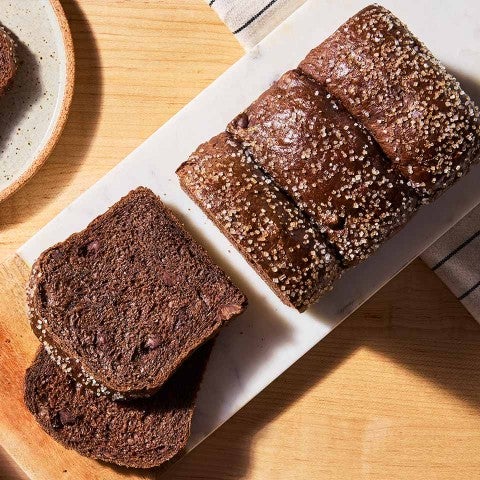Yeast
Yeast is a single-celled organism classified in the kingdom Fungi, and requires moisture, oxygen, food, and appropriate temperatures in order to survive. Under these suitable conditions, the yeast will reproduce and generate alcoholic fermentation. During fermentation, yeast and bacteria consume sugars, and the resulting products are alcohol and carbon dioxide.
Generally speaking, bread dough is an ideal environment for the yeast, providing all the necessary conditions for its needs.
- Water is needed by the yeast, since the semipermeable yeast cell wall can only absorb small molecule nutrients in a dissolved state. It is well known by bakers that salt retards the activity of yeast fermentation, due to osmotic pressure exerted on the yeast cells by the salt. Salt, being hygroscopic (attracting moisture), draws water out of the yeast cell, reducing the amount available to the yeast, and this is why there is a decrease in fermentation from the presence of salt. Sugar acts the same way. It too is hygroscopic, and once a dough contains more than 10% sugar, a decrease is noted in the rate of fermentation.
- Oxygen, obtained mostly by the mixing of the dough, enables the yeast to metabolize nutrients and to multiply. Although yeast requires oxygen for its reproduction, in reality there is almost no reproduction occurring in bread dough, and the rise we see is almost entirely due to gas production during fermentation. Available oxygen is used up within a matter of minutes after dough mixing, and fermentation occurs in an anaerobic environment.
- Dough temperature is crucial for yeast activity. For commercial yeast, the optimum temperature for fermentation is 86° to 95°F or even higher. It is important to note, however, that a dough temperature in this range is inappropriate; although fermentation would be favored, it would occur at the expense of flavor development, which requires lower temperatures. Wild yeasts prefer a narrower temperature zone than commercial yeast, and in general perform better at slightly lower temperatures than commercial yeast.
During fermentation, food is provided to the yeast by the conversion of starches (by amylase enzymes) into sugar. The yeast ferments the sugar, and as a result of this fermentation, carbon dioxide gas and alcohol are produced. The CO2 is trapped by the gluten network in the dough, and provides volume to the baked loaf. The alcohol is largely evaporated during the baking of the bread. Another by-product of fermentation is heat.
Kinds of yeast
In nature, there are dozens of genera of yeast, hundreds of species, and thousands of subspecies or strains. Saccharomyces cerevisiae is the strain that has been chosen for commercial yeast, because it has characteristics that favor rapid gas production. Commercial yeast is available in a number of forms, from cream yeast (a liquid form of compressed yeast, it is usually delivered in tank trucks to storage bins, and is used in very large operations), to compressed yeast (also called cake yeast or fresh yeast), and finally, active dry yeast and instant yeast. There is also osmotolerant yeast, which is designed for enriched formulas with less water.
Conversions
When converting from fresh yeast to dry yeast, it is important to adjust the weight of the yeast. Although it is best to follow the conversion ratio provided by the manufacturer, there are general conversion guidelines that may prove helpful.
- To convert from fresh yeast to active dry yeast, multiply the fresh quantity by 0.4. Active dry yeast must be hydrated in warm water before being incorporated into a dough.
- To convert from fresh yeast to instant dry yeast, multiply the fresh quantity by 0.33. Instant yeast can be incorporated into the dough without first rehydrating it; however, it is sensitive to ice or ice-cold temperatures, and if the water temperature of the dough is cold, it is best to mix the dough for a minute or two before adding the yeast. In order to maintain dough yield, most manufacturers suggest making up the weight difference between dry yeast and fresh with additional water.
A symbiotic relationship
There is an interesting relationship in what we call San Francisco Sourdough between the wild yeast, Candida milleri, and the dominant lactobacillus strain, Lactobacillus sanfranciscensis. C. milleri cannot utilize maltose during fermentation, while Lb. sanfranciscensis is happy to use it. And once it does, it excretes glucose. This is fortunate for C. milleri, because it is fond of glucose, and ferments this simple sugar readily. At the same time, competing bacterial species are inhibited by the presence of so much glucose, and this is to the benefit of Lb. sanfranciscensis, whose development is therefore favored. A last factor in this relationship pertains to acidity. Lb. sanfranciscensis produces a lot of acetic acid, which contributes significantly to the flavor we associate with sourdough bread. C. milleri is more tolerant of an acidic environment than many yeast varieties. The high level of acidity prevents competing yeasts from dominating the culture, much to the benefit of C. milleri.








